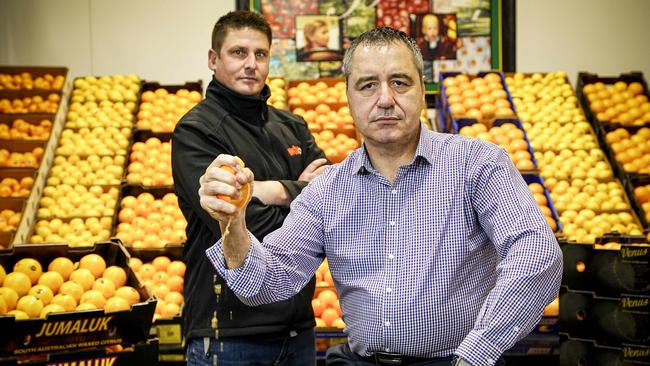SA’s fruit ban confusion: Your questions answered
The ban on moving fruit around some areas in Adelaide has many people baffled. Here we answer your questions about the restrictions.
Lifestyle
Don't miss out on the headlines from Lifestyle. Followed categories will be added to My News.
Which fruits are affected by the State Government’s fruit fly ban? What’s the difference between an outbreak area and a suspension area? And what should you do if you have a backyard fruit tree in an outbreak zone? Here we answer your questions about the confusing new rules around fruit.
SO WHAT’S THE BOTTOM LINE?
Several fruit fly outbreaks around the state have led the SA Government to implement bans in some areas around moving some types of fruit – so you can no longer take fruit that could spread fruit fly to school or work. They’ve declared some places as “outbreak areas” and others as “suspension areas”.
WHAT IS THE DIFFERENCE BETWEEN AN OUTBREAK AREA AND A SUSPENSION AREA?
When fruit fly is found, a 1.5km-radius outbreak area is established in the immediate vicinity of the discovery. A 7.5km-diameter suspension area is also defined for Mediterranean fruit fly and 15km-diameter suspension area for Queensland fruit fly.
People in outbreak areas must not move any fruit off of their properties. People in suspension areas are encouraged to limit fruit movement as much as possible and must not move it outside of the suspension zone.
WHERE HAS FRUIT FLY BEEN DISCOVERED?
There are outbreak areas in the Riverland and metropolitan Adelaide.
In the Riverland, Queensland fruit fly has been found in backyard fruit trees in Renmark West and Monash. In Adelaide, Mediterranean fruit fly was discovered in Pooraka, Blair Athol, Angle Park, Rosewater, Semaphore Park, Croydon Park, Klemzig, Campbelltown and Black Forest.
WHICH SUBURBS AND TOWNS ARE NOW IN THE SUSPENSION AREAS?
■ ADELAIDE: There are now 297 suburbs in suspension areas, between Sturt and Eden Hills in the south, and Salisbury in the north, and from the coast to Highbury and Mount Osmond in the east. Click here for a high-res map showing the outbreak and suspension areas.
■ RIVERLAND: Areas include Monash, Barmera, Berri, Bookpurnong, Bugle Hut, Calperium Station, Chaffey, Cobdogla, Cooltong, Crescent, Gerard, Glossop, Gurra Gurra, Hawks Nest Station, Katarapko, Kingston on Murray, Loveday, Lyrup, Monash, Moorook, Mundic Creek, Murtho, Old Calperium, Overland Corner, Paringa, Pike River, Renmark, Renmark North, Renmark South, Renmark West, Spectacle Lake, Winkie, Wonuarra and Yamba. Click here for a high-res map showing the outbreak and suspension areas.
WHICH FRUITS AND VEGETABLES ARE FRUIT FLY HOSTS?
Fruits such as bananas, apples, oranges, kiwifruits, mandarins, mangoes, cherries, blueberries and fruiting vegetables such as tomatoes, eggplants and capsicums. See the full list here.
For more information, visit https://pir.sa.gov.au/biosecurity/fruit_fly_in_sa
WHAT SHOULD I DO IF I’M IN AN OUTBREAK AREA?
You must keep fresh homegrown fruit or fruiting vegetables on your property. You can eat, cook or preserve your own homegrown produce. Host fruit bought at shops or markets must be kept secure when taken home and must then remain at home. This means it can’t be included in lunch boxes or otherwise moved around.
Collect fallen or over-ripe fruit from around your property and place it in your green bin. Do not compost it. If you do not have a green bin service, seal your unwanted fruit in an airtight bag and call the Fruit Fly Hotline on 1300 666 010 to arrange collection.

WHAT SHOULD I DO IF I’M IN A SUSPENSION AREA?
Don’t move fruit out of your suspension area, and limit the unnecessary movement of fruit from your home. It’s fine to buy fruit from your local fruit and veg shop or supermarket and take it home.
WHAT CAN I TAKE TO SCHOOL OR WORK INSTEAD?
Non-fruit fly host vegetables such as snow peas and sugar snap peas, carrots, celery, cucumbers, potatoes, pumpkins and leafy vegetables such as lettuce and baby spinach
Cooked fruit, processed fruit (such as fruit straps), fruit puree, canned, dried or frozen fruit.
Pineapples and melons, as they are not fruit fly host vegetables.
WHY IS THIS SO IMPORTANT?
The State Government wants to reduce the movement of fruit to prevent the spread of fruit fly, which threatens the viability of the state’s $1.3bn horticulture industries vulnerable to fruit fly. With 12 outbreaks over the past year, it is unlikely the outbreaks were caused by flies moving within their normal range, but rather by settling in new areas after larvae-infested fruit had been moved by people.



